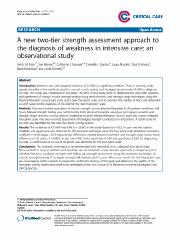Please use this identifier to cite or link to this item:
https://ahro.austin.org.au/austinjspui/handle/1/12746| Title: | A new two-tier strength assessment approach to the diagnosis of weakness in intensive care: an observational study. | Austin Authors: | Parry, Selina M;Berney, Susan C ;Granger, Catherine L ;Dunlop, Danielle L;Murphy, Laura;El-Ansary, Doa;Koopman, René;Denehy, Linda | Affiliation: | School of Health Sciences, Physiotherapy Department, The University of Melbourne, Level 7 Alan Gilbert Building, 161 Barry Street, Parkville, 3010, VIC, Australia Department of Physiology, The University of Melbourne, Grattan Street, Parkville, 3010, VIC, Australia Department of Physiotherapy, Austin Health, 145 Studley Road, Heidelberg, 3084, VIC, Australia |
Issue Date: | 26-Feb-2015 | Publication information: | Critical Care 2015; 19(): 52 | Abstract: | Intensive care unit-acquired weakness (ICU-AW) is a significant problem. There is currently widespread variability in the methods used for manual muscle testing and handgrip dynamometry (HGD) to diagnose ICU-AW. This study was conducted in two parts. The aims of this study were: to determine the inter-rater reliability and agreement of manual muscle strength testing using both isometric and through-range techniques using the Medical Research Council sum score and a new four-point scale, and to examine the validity of HGD and determine a cutoff score for the diagnosis of ICU-AW for the new four-point scale.Part one involved evaluation of muscle strength by two physical therapists in 29 patients ventilated >48 hours. Manual strength testing was performed by both physical therapists using two techniques: isometric and through range; and two scoring systems: traditional six-point Medical Research Council scale and a new collapsed four-point scale. Part two involved assessment of handgrip strength conducted on 60 patients. A cutoff score for ICU-AW was identified for the new four-point scoring system.The incidence of ICU-AW was 42% (n = 25/60) in this study (based on HGD). In part one the highest reliability and agreement was observed for the isometric technique using the four-point scale (intraclass correlation coefficient = 0.90: kappa = 0.72 respectively). Differences existed between isometric and through-range scores (mean difference = 1.76 points, P = 0.005). In part two, HGD had a sensitivity of 0.88 and specificity of 0.80 for diagnosing ICU-AW. A cutoff score of 24 out of 36 points was identified for the four-point scale.The isometric technique is recommended with reporting on a collapsed four-point scale. Because HGD is easy to perform and sensitive, we recommend a new two-tier approach to diagnosing ICU-AW that first tests handgrip strength with follow-up strength assessment using the isometric technique for muscle strength testing if handgrip strength falls below cutoff scores. Whilst our results for the four-point scale are encouraging, further research is required to confirm the findings of this study and determine the validity of the four-point scoring system and cutoff score developed of less than 24 out of 36 before recommending adoption into clinical practice. | Gov't Doc #: | 25882719 | URI: | https://ahro.austin.org.au/austinjspui/handle/1/12746 | DOI: | 10.1186/s13054-015-0780-5 | Journal: | Critical Care | URL: | https://pubmed.ncbi.nlm.nih.gov/25882719 | Type: | Journal Article |
| Appears in Collections: | Journal articles |
Files in This Item:
| File | Description | Size | Format | |
|---|---|---|---|---|
| 25882719.pdf | 505.83 kB | Adobe PDF |  View/Open |
Page view(s)
98
checked on Dec 25, 2024
Download(s)
156
checked on Dec 25, 2024
Google ScholarTM
Check
Items in AHRO are protected by copyright, with all rights reserved, unless otherwise indicated.
